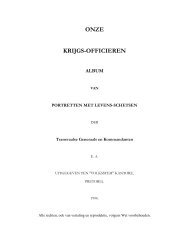Boere Krygsgevangenes in Ceylon - Boekmakierie.co.za
Boere Krygsgevangenes in Ceylon - Boekmakierie.co.za
Boere Krygsgevangenes in Ceylon - Boekmakierie.co.za
Create successful ePaper yourself
Turn your PDF publications into a flip-book with our unique Google optimized e-Paper software.
the people of <strong>Ceylon</strong>. When the local press <strong>in</strong>itially splashed <strong>in</strong> headl<strong>in</strong>es the secret<br />
which had been carefully preserved, the was much public doubt as to the wisdom of the<br />
arrangement. A “family man and tea-planter”, wrote to the local papers:- “Imag<strong>in</strong>e what<br />
it would mean to <strong>Ceylon</strong> if it were saddled with more Boer prisoners than there are<br />
European British subjects. As prisoners-of-war are not <strong>co</strong>nf<strong>in</strong>ed to prison walls and<br />
treated like crim<strong>in</strong>als, how are they to be guarded, and what should be given them to do?<br />
It would be madness on the part of England to send a large number of prisoners to<br />
<strong>Ceylon</strong>. The very thought of thousands of Boer prisoners-of-war <strong>in</strong> the Island, is enough<br />
to depreciate our great <strong>in</strong>dustry and create a long<strong>in</strong>g desire to go out of the <strong>co</strong>untry.”<br />
Yet others fancifully stressed the fact that the entire European population of <strong>Ceylon</strong> at<br />
that time did not exceed six thousand, while the arrangement foreboded the advent of five<br />
thousand “rough, uncultured, crafty and treacherous” Boer prisoners, with no more than a<br />
thousand troops to guard them. In domestic circles fears were enterta<strong>in</strong>ed <strong>co</strong>ncern<strong>in</strong>g the<br />
enhanced prices of provisions and foodstuffs which would directly result from this<br />
enforced <strong>in</strong>vasion. Even the wise and prudent shook their heads disapprov<strong>in</strong>gly.<br />
But <strong>in</strong> its Governor, <strong>Ceylon</strong> at that time possessed a great diplomat. What is more, Sir<br />
West Ridgeway was a great orator. Us<strong>in</strong>g every opportunity to give public utterance to<br />
his views he gradually allayed all fears. He assured the house-wife that at the most “the<br />
price of pumpk<strong>in</strong>s might possibly rise!” The happy results he anticipated from tak<strong>in</strong>g the<br />
public <strong>in</strong>to his <strong>co</strong>nfidence soon <strong>in</strong> great measure realized. Controversy gradually<br />
subsided, and <strong>Ceylon</strong> settled down to view with a measure of <strong>co</strong>mplacency the arrival of<br />
the Boer captives. The model Imperial sanatorium which today enjoys the perfection of<br />
climate <strong>in</strong> ideal surround<strong>in</strong>gs, and is so well known throughout the Indian and Eastern<br />
world, was the dis<strong>co</strong>very of this Imperial experiment.<br />
Ever s<strong>in</strong>ce those early days when the British occupied the central portion of <strong>Ceylon</strong>,<br />
Upper Ava was regarded as a favoured region and the healthiest part of the Island.<br />
Diyatalawa was just a speck <strong>in</strong> a glorious stretch of landscape – noth<strong>in</strong>g more.<br />
About thirteen years before the arrival of the Boer prisoner-of-war <strong>in</strong> <strong>Ceylon</strong>, a tract of<br />
land <strong>in</strong> Diyatalawa (literally “the watered pla<strong>in</strong>”) was leased from Government by the<br />
Rev. Samuel and Mrs. Langdon as the site for an Orphanage and Industrial School. It is<br />
recalled that when the foundation of the orphanage build<strong>in</strong>gs were be<strong>in</strong>g laid, only the<br />
few huts of the labourers employed on the work splashed the outlook of the roll<strong>in</strong>g<br />
patana. The only other build<strong>in</strong>g on which the eye rested was the club house on Wilson’s<br />
Pla<strong>in</strong>s, several miles distant. With the gradual growth and development of the Wesleyan<br />
Missionary Settlement, the place came to be known as “Happy Valley”. The Mission<br />
House was built after the Orphanage, <strong>in</strong> turn there sprang up the Reformatory and<br />
Hospital.<br />
F<strong>in</strong>ally, a prettily situated Chapel was erected on a site off what is today called the Polo<br />
Ground. The valley was <strong>co</strong>nsequently gradually crowded with numbers of busy workers,<br />
some tend<strong>in</strong>g plots which were planted <strong>in</strong> Tea, others learn<strong>in</strong>g a trade <strong>in</strong> carpentry or<br />
other <strong>in</strong>dustrial pursuits. Diyatalawa and the Happy Valley thus became a frequented





